How to collect a diamond mosaic?
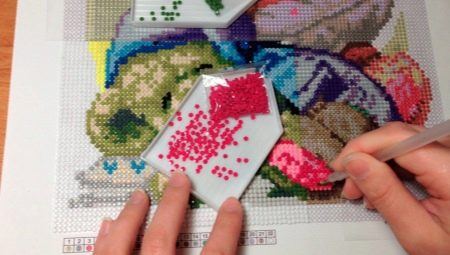
Diamond embroidery is a popular type of needlework, relatively new, so many are just looking at it. To many, the process of making a picture with rhinestones seems complicated: suddenly it does not work out, there is not enough patience. This material will help you understand the intricacies of the technique and will allow you to prepare for the exciting process of drawing up a mosaic picture.

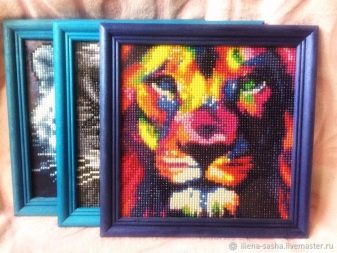
What is necessary?
Diamond embroidery itself is a technique, the main element of which is acrylic rhinestones. Round and square crystals are glued to a circuit covered with a special adhesive base. The canvas itself is divided into cells, each cell is numbered. The task of the embroiderer is to arrange rhinestones from bags with numbering according to the corresponding cells on the canvas.
What the standard set provides.
- Canvas with special rubberized fabric. An image has already been applied to it, on which pebbles will be laid out. In most kits, the canvas is stretched over a wooden stretcher. Above the image on the canvas is an adhesive base. Due to this layer, rhinestones are attached to the surface.
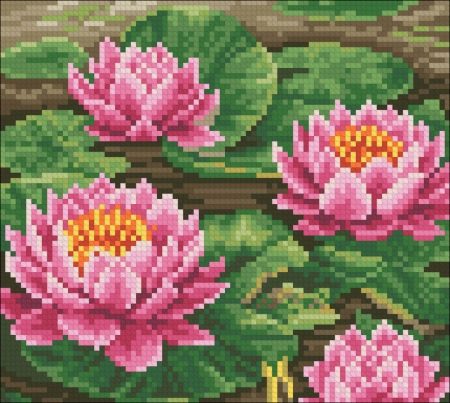
- Foil on top of the adhesive backing. It must be fixed on the canvas, otherwise the base will lose its stickiness.
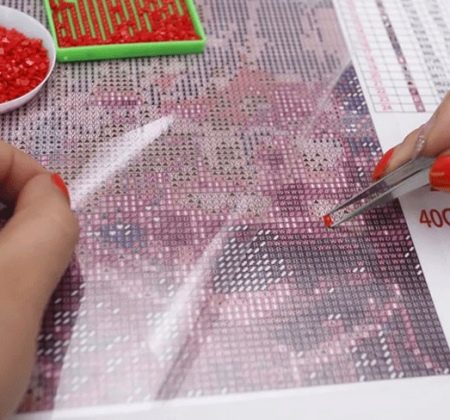
- A pebble tray, often with a ribbed bottom. These ribs are needed so that when you shake the tray, the rhinestones themselves turn over to the right side and line up in rows.
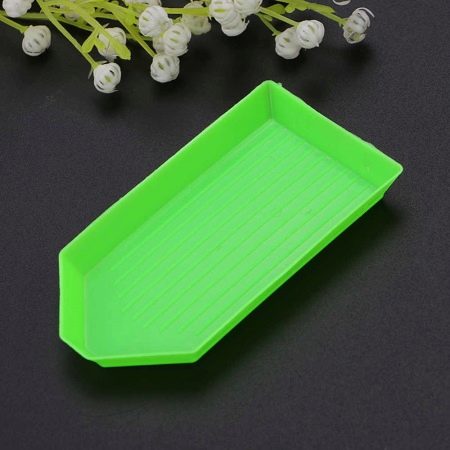
- Bags with rhinestones. All colors are distributed in sachets, each one is numbered. You need to work with the flowers one by one, pouring the desired batch into the tray. One side of the stone is flat, and it will be attached to the adhesive base.

- Hollow-tipped stylus. This is the main tool for working with embroidery, for laying out elements. The stylus moves the crystals onto the diagram.The tool is first immersed in a special silicone fragment (always included in the set) so that its tip adheres better to the rhinestone. There are stylus in the set that can pick up several rhinestones at once, which allows you to lay out single-color sections of embroidery much faster.

- Silicone piece (adhesive pad). It should be wrapped in cellophane. Its task is to interlock the pebble and the tip of the stylus. The hollow part of the instrument must be pressed against the mass, it will go into its cavity and remain there.
When the mass inside the stylus is no longer sticky, you can pull it out with a toothpick or needle, and immerse the tool in the silicone again.
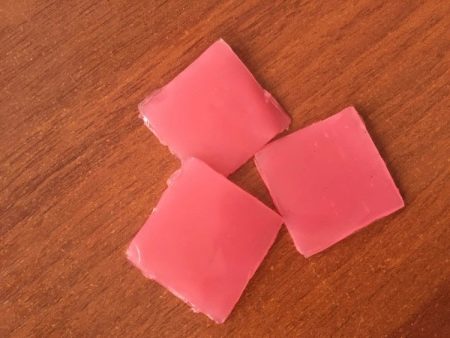
- Tweezers. It is convenient to grip square rhinestones with this tool.

- Decoding the scheme. It helps to match colors, gives a clearer image, which can be checked against the sample.
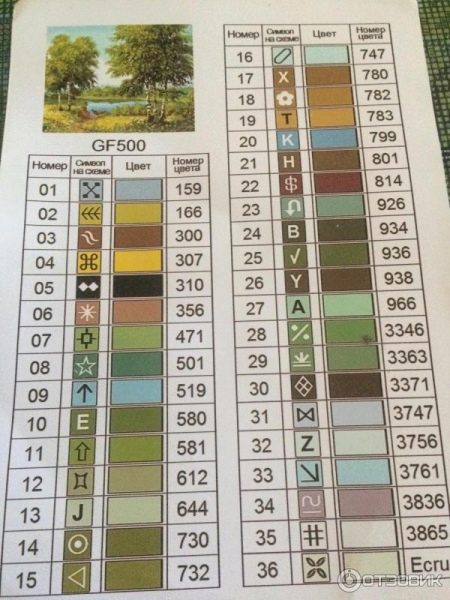
- Glue. Not every set has, but maybe. If the base has lost its stickiness, it will help it recover. This happens when they started embroidery, then did not do it for a long time, and after a break, they noted the insufficient stickiness of the canvas.

It will be great if everything in the set is thoughtful and practical. For example, zip-lock bags are much more convenient than sealed bags. The master pours the stones into the tray and again closes the bag valve tightly, that is, does not allow the stones to crumble.
Preparation
It is more convenient to work at a spacious table. Good lighting is a must. It is better if it is daytime, and the table by the window fits well into the concept of a comfortable and safe place for creativity.


Open the set carefully so as not to damage the bags with rhinestones. There are sets not only with a tray, but also with a whole organizer, that is, a multi-cell system. It is assumed that all rhinestones are distributed among the cells, each type - in its own cell. But all the same, actual pebbles (that is, those with which you have to work right now) are poured into the ribbed tray.
Immediately you need to think about where you have to remove all the material when the work is interrupted. If there are small children or pets in the house, it will be difficult to keep everything safe and sound until the next handicraft session.


Layout instructions
There are several options for how exactly the pebbles can be laid out. The principle of "convenient-inconvenient" works here, there are no universal advice.
Consider how a diamond mosaic is laid out.
- By color or staggered. The sequence of gluing will be clear, the image will not be able to shift - these are the indisputable advantages of this method of laying out.

- In rows. Everything is fine, but the drawing may shift. If the set has a stylus that can capture 3 elements at once, you can work faster.
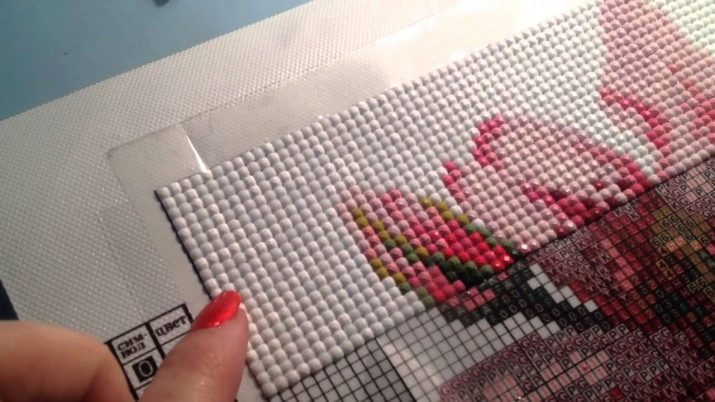
- Sectors, stripes. We released the protective film by 6 cm, laid out the released fragment, etc. Most craftsmen prefer to use this method.

More details should be said about the protective film. You cannot shoot it all at once. As soon as one area is filled, the second is released. And so on, as you move along the canvas. If you remove the film immediately, everything will cling to the glue base: the pebbles will not "fly" to their place, dust and hair also instantly remain on the glue base. If the problem already exists and the base is dry, you need the glue from the kit. If this is not provided, you will have to use a glue gun or its equivalent.
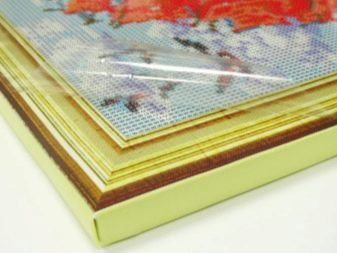

A master class on laying out diamond embroidery will step by step help you in your work.
- Lay out the painting on the table. Check the numbering of the stones, whether the colors match (compare the printout with the contents of the bags).
- Choose which fragment to start with. Pour rhinestones of the desired color into a tray with grooves.
- With tweezers or stylus (special stick) the pebble is sent to the cell, which is marked with its color. You need to press a little on the element so that it adheres exactly. If there are deformed rhinestones or a little lost, it's okay.Usually they are poured into bags with a 20 percent margin.
- When crystals are stacked in several rows, you can put a regular ruler on them and once again press the laid out elements to the base. You can also move the row up with a ruler if the pebbles are outside the line.
- From site to site - and the work will be completed. First, one color is laid out completely and only then the pebbles of the other should be glued. This is not a strict rule, but the most comfortable one for the masters.

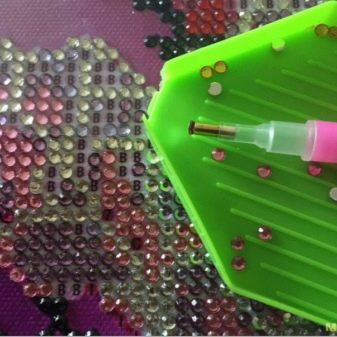
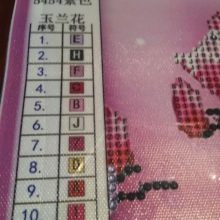
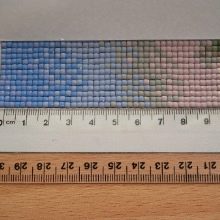
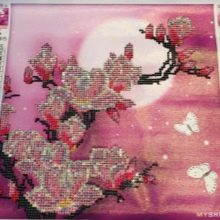
Collecting embroidery is not difficult, but not at all fast. Even a small picture is unlikely to come together in an evening. To embroider a diamond painting, for example, measuring 30 by 20 cm, it will take several evenings, about 3-5. When the work is interrupted, the protective film that comes from above must cover the already made fragments. At least a little, it will protect the stacked rhinestones from falling out and displacement.
In principle, after all the rows are ready, you can look for a place in the house for the picture. But it is better to make a control fixation of the stones with varnish. Both glossy and matt varnish are used. A couple of layers - and the details of the picture are well bonded to each other, they will not fall out. And shine can only decorate the picture. You can use both varnish in cans and liquid cans, which are applied with a brush.
If it is applied in two layers, the second is applied only after the first is completely dry.
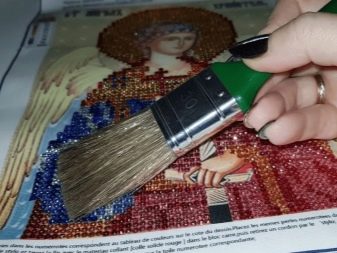
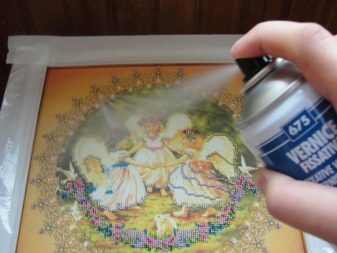
By the way, interrupted work (or finished, but still unformed, without a stretcher) can be twisted into a tube. If folded in half, there will be creases and it is almost impossible to fix.
Registration
A stretcher for a diamond painting can be made by hand. Someone wears embroidery to a baguette workshop for a professional design. But a diamond painting is rarely sent under glass: rhinestones do not need such a design. But if it hangs in a place that is prone to dust or excess moisture, you can arrange the work in glass.

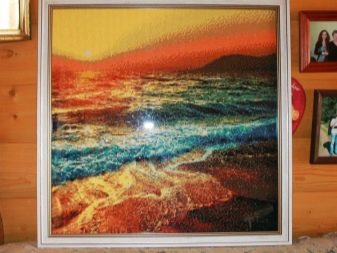
DIY framing is easy to do.
- You need to choose a plywood (or thick cardboard) base according to the size of the frame, so that you can then insert the work there.
- The picture is carefully glued to the base. You can use either transparent glue or double-sided tape for this.
- The fabric is ironed with a wallpaper roller to eliminate the formation of wrinkles.
- The picture is placed in a frame.
If the canvas is immediately stretched onto a stretcher, the picture does not need to be framed at all. The kit may include fasteners that will help fix the finished embroidery on the wall. Very often the frame is really superfluous, it is not necessary to make it.

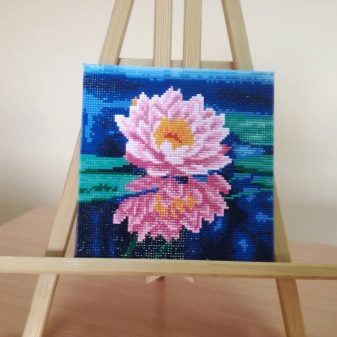
Useful Tips
In the process of working on embroidery, the master may have questions that are rarely written in the instructions. But there are answers to them too.
- If small debris has formed on the working surface (for example, fluff from clothes), it must be removed. It's easier to do this with a clean, synthetic-bristled paint brush.
- Of all the varnishes, the most convenient, as practice shows, is acrylic water-based. A thin, even layer is sufficient to fix the stones to the surface.
- A failed adhesive base can be made by yourself, using, for example, double-sided tape. The tape is neatly glued to the desired section of the circuit, then the circuit itself is laid out. The protective layer is removed gradually.
- If the canvas itself is deformed, it no longer looks smooth, creases have formed on it, you can iron it. The iron is set to a low temperature, you need to iron from the inside out.
- If rhinestones of a certain color run out, you can take pebbles of similar shades.
- For the first time, it is more convenient to work with products of postcard sizes. And the labor intensity is not so great, and the result will be faster. The first successful experience will add confidence and it will be possible to encroach on other volumes.
- A pebble that has got out of the row can be easily corrected with the back of the stylus. And yet it will be useful to use a ruler several times during the whole process to trim all the rows.
- When you have to work with a very bulky product, you will not keep it open all the time. Part of the canvas should remain rolled up - this is important for the picture (so as not to deform), and for the convenience of the master.
- In the process of drying an already varnished picture, you need to make sure that garbage does not cling to it, the same villi. We'll have to think about a safe drying for the painting.
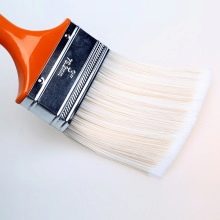

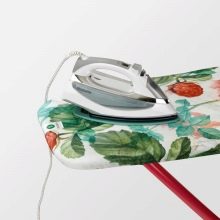
The lacquered picture can be cleaned with a damp cloth. The expectation that it will linger in the interior for years, or even decades, is quite reasonable, if everything is done correctly.
Enjoy your creativity!
The next master class for beginners will tell you how to collect a diamond mosaic.








